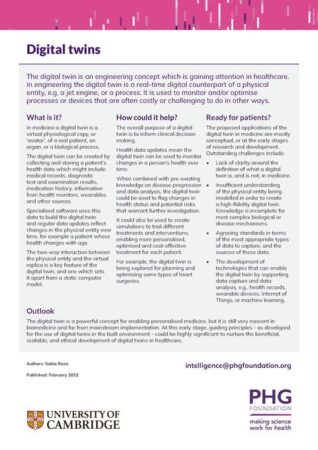Read more perspectives on digital twin technology in our longer read: Digital twins for better health
The digital twin is an engineering concept which is gaining attention in healthcare. In engineering the digital twin is a real-time digital counterpart of a physical entity, e.g. a jet engine, or a process. It is used to monitor and/or optimise processes or devices that are often costly or challenging to do in other ways.
What is it?
In medicine a digital twin is a virtual physiological copy, or ‘avatar’, of a real patient, an organ, or a biological process.
The digital twin can be created by collecting and storing a patient’s health data which might include medical records, diagnostic test and examination results, medication history, information from health monitors, wearables and other sources.
Specialised software uses this data to build the digital twin and regular data updates reflect changes in the physical entity over time, for example a patient whose health changes with age.
The two-way interaction between the physical entity and the virtual replica is a key feature of the digital twin, and one which sets it apart from a static computer model.
How could it help?
The overall purpose of a digital twin is to inform clinical decision making.
Health data updates mean the digital twin can be used to monitor changes in a person’s health over time.
When combined with pre-existing knowledge on disease progression and data analysis, the digital twin could be used to flag changes in health status and potential risks that warrant further investigation.
It could also be used to create simulations to trial different treatments and interventions, enabling more personalised, optimised and cost-effective treatment for each patient.
For example, the digital twin is being explored for planning and optimising some types of heart surgeries.
Ready for patients?
The proposed applications of the digital twin in medicine are mostly conceptual, or at the early stages of research and development. Outstanding challenges include:
- Lack of clarity around the definition of what a digital twin is, and is not, in medicine.
- Insufficient understanding of the physical entity being modelled in order to create a high-fidelity digital twin. Knowledge is incomplete for most complex biological or disease mechanisms.
- Agreeing standards in terms of the most appropriate types of data to capture, and the sources of these data.
- The development of technologies that can enable the digital twin by supporting data capture and data analysis, e.g., health records, wearable devices, Internet of Things, or machine learning.
Outlook
The digital twin is a powerful concept for enabling personalised medicine, but it is still very nascent in biomedicine and far from mainstream implementation. At this early stage, guiding principles – as developed for the use of digital twins in the built environment – could be highly significant to nurture the beneficial, scalable, and ethical development of digital twins in healthcare.

